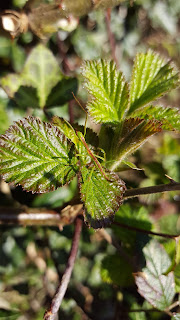 |
| Unarmed Stick Insect, Acanthoxyla inermis |
The routes of introduction of non-native species into the island of Ireland are many, with the vast majority of those in the past 200 years being mediated by human activities. Many have been deliberate, with the species' adaptability to Irish conditions often leading to their proliferation, such as the catastrophic establishments of the invasive plants Rhododendron ponticum, Japanese Knotweed (Reynoutria japonica) and Winter Heliotrope (Petasites fragrans). Other instances have been accidental, and the happenstance of their presence have been as surprising as the species themselves.
One such example is the Unarmed Stick Insect, Acanthoxyla inermis. While the order of stick insects is distributed worldwide, Europe has only 17 species of native stick insects, with none being present on the island of Ireland. That is, however until late in the 19th century when Samuel Thomas Heard began to lay out his garden in Rossdohan Island in Kenmare, Co. Kerry.
Born in Cork, Samuel was an Indian Army Surgeon-Major until his retirement, when he bought the island of Rossdohan in Kenmare Bay in 1873. He proceeded to turn this uninhabited island of closely cropped vegetation into an exotic garden. His interest in gardening began in his youth, with many collections begin amassed in places such as Fota, Castlemartyr and Doneraile near his family seat at Ballintober, near Kinsale Co. Cork. This was further fuelled in Paris, a city he spent some time in upon graduating in medicine. There, the experiments in bedding out subtropical plants in the city's parks by Jean-Pierre Barillet-Deschamps were causing a stir worldwide. During his time in India, Samuel also became familiar with the Madras Horticultural Gardens. However probably his greatest influence when it came to laying out his garden in Rossdohan was his wife Kate Bradley, whom he married in 1862. Kate was from New South Wales in Australia and this inspired the import of many Australasian florae. It was the importation of plants and soil from New Zealand that is linked with the establishment in the area of the Unarmed Stick Insect, A. inermis. This the source of which was Treseders Nursery in Truro, England. James Treseder took over the running of the nursery in 1820 and quickly developed the business. His sons all unsuccessfully tried their luck in the Australian gold fields but soon gave this up to run a successful nursery in Sydney. James' son John began the export to Europe of plants from Australia, New Zealand and Tasmania that he, correctly, though would be hardy enough to withstand the different climate.
A. inermis, along with many other species of Phantasmids, reproduces parthenogenetically with males being virtually non-existent in established colonies. Several hundred eggs are laid by females in summer and early autumn so plant and soil material containing these can readily establish a new colony if transported elsewhere. The adults are polyphagious and slow moving with therefore little inclination to move elsewhere which means that colonies tend to be localised. This is very much the case with the population in Ireland, which is restricted to pockets around Kenmare. These areas are either associated with materials source directly from New Zealand (such as the colony in Derreen Gardens) or with the taking of material from Rossdohan and Derreen: the house at Rossdohan was burned down in 1923 and the estate all but abandoned for a period after Irish independence, leading to plants being taken from there by locals. A. inermis is now established at a garden centre in Kenmare, increasing the likelihood that its range will be extended further as material is disseminated from there.
While I was aware of its presence in the Kenmare area, it did come as a pleasant shock for me to find an individual in a suburban garden in Cork City. On the 16th of March, 2021, I found a juvenile wandering about some potted strawberry plants near some brambles in my back garden. The size of the individual and the time of the sighting indicates that it had hatched close-by, most likely from material source from Kenmare. The garden in question is closely bordered by a number of others all of which share the same bramble hedges.
 |
| Juvenile Unarmed Stick Insect seen in Cork City |
A. inermis grows to 90-125mm in length making them easily the largest insects on the island of Ireland. The body is smooth, although a few small tubercles may be present. The cerci are rounded. Body colour varies from green to brown, with brown specimens ranging from yellow to almost black. They feed on various members of the Rosaceae family, of which at least two were present near where this juvenile individual was found. It displayed a trait for which the A. inermis is well known, namely swaying from side to side as it moved. This is thought to aid camouflage by coping the movement of foliage in the wind.
References:
Lee, M. (2007) The Naturalised Stick-insects in South-west England. Atropos 32: 31-37
Malins, E. and Bowe, P. (1980) Irish Gardens and Demesnes from 1830 Barrie & Jenkins








